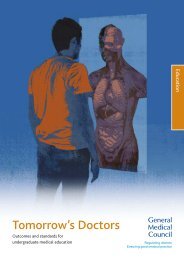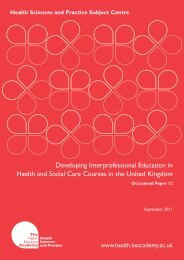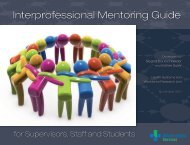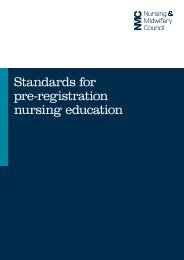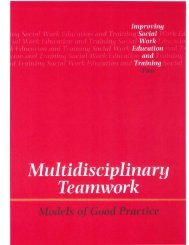(WHO) Patient Safety Curriculum Guide - CAIPE
(WHO) Patient Safety Curriculum Guide - CAIPE
(WHO) Patient Safety Curriculum Guide - CAIPE
You also want an ePaper? Increase the reach of your titles
YUMPU automatically turns print PDFs into web optimized ePapers that Google loves.
How to assess the capacity of faculty<br />
to integrate patient safety teaching into<br />
the existing curriculum<br />
One of the biggest challenges facing all health<br />
professions is the growing shortage of workplace<br />
teachers generally. There are few who know how<br />
to integrate patient safety principles and concepts<br />
into structured teaching in a new area and many<br />
will find the content unfamilar. Many health<br />
professionals intuitively adopt patient safety<br />
methods into their everyday practice, but may not<br />
know how to articulate what they do. This may<br />
be because they view any discussions about<br />
“systems” as the province of administrators<br />
and managers. Others may not think patient<br />
safety teaching important or relevant to their area<br />
of practice but patient safety concerns everybody.<br />
Most health-care professionals today would be<br />
conscious of the need for patient safety, but<br />
because this area is so new to curriculum,<br />
engaging health-care professionals will be<br />
the first challenge for you. Building capacity<br />
of the faculty can take time, but there are<br />
a number of steps that can be taken to engage<br />
clinicians in patient safety teaching.<br />
Survey<br />
One way to find out who is interested in teaching<br />
patient safety is to conduct a survey of those<br />
who teach students. In some institutions there<br />
may be hundreds of teachers and in others not<br />
so many. Identify the persons who are in the best<br />
position to incorporate patient safety teaching<br />
and ensure that they are included in the survey.<br />
The mapping exercise described above will help<br />
identify faculty staff who currently teach and are<br />
in a position to integrate patient safety concepts.<br />
The survey could include questions related to<br />
an interest or knowledge of patient safety<br />
and practice in patient safety methods. This<br />
process could also identify persons interested<br />
in forming a group or committee to oversee<br />
the development of the patient safety curriculum<br />
in your particular profession.<br />
Focus group<br />
Run a focus group of health professionals from<br />
your particular profession to find out what<br />
the current state of knowledge is about patient<br />
safety. This will also provide information about<br />
their attitudes towards patient safety learning<br />
in the curriculum.<br />
Face-to-face meetings<br />
Individual meetings with faculty staff and<br />
workplace teachers from your profession will help<br />
to convey a clear message about patient safety<br />
education. This provides an opportunity to explain<br />
the basis and urgency for patient safety education<br />
as well as to establish a relationship for later work.<br />
Convene a round table<br />
Invite a select group of people from your<br />
profession who you think may be interested<br />
and might be possible role models or<br />
“champions” to participate to a round table<br />
discussion about patient safety education for<br />
students. (The benefit of a round table format<br />
is that there is no one expert obviously in charge<br />
and the group seeks to discuss and resolve<br />
the issues together in a collegial fashion.)<br />
Conduct a seminar on patient safety<br />
Seminars are typical venues for building new<br />
knowledge. Seminars are useful for exposing<br />
practitioners new to the area as, well as to experts<br />
or respected practitioners who are knowledgeable<br />
about patient safety. Seminars can either be<br />
a half-day or a full day. Topics could include:<br />
(i) what is patient safety?; (ii) the evidence<br />
of why patient safety is important; (iii) how to<br />
develop a curriculum for patient safety; (iv) how<br />
to teach patient safety; and (v) how to assess<br />
patient safety. It is important to remember<br />
to maintain the aim of the programme, which<br />
is to build capacity for faculty staff and<br />
professionals to teach patient safety to students.<br />
How to identify like-minded colleagues<br />
or associates<br />
If you undertake the activities set out above in<br />
relation to building capacity, this will help identify<br />
like-minded people interested in teaching patient<br />
safety. Another way is to convene a meeting<br />
and send an open invitation to faculty staff and<br />
teachers. Make sure to schedule the meeting at<br />
a time convenient for as many people as possible<br />
in order to attract maximum attendance (e.g.<br />
some professions who see patients during the day<br />
may want to come, but cannot because of work<br />
demands). Another way is to put an article in the<br />
faculty or university newsletter. This will let people<br />
know about patient safety, and even if they are<br />
not interested in getting involved, the article<br />
will raise awareness of the need to include patient<br />
safety education in the curriculum.<br />
<strong>Patient</strong> safety teaching requires the person<br />
responsible for implementing the programme<br />
to engage interested and knowledgeable health<br />
professionals who have identified themselves<br />
or have been appointed or nominated as a result<br />
of previous contacts or meetings about patient<br />
safety. It is also a good idea to check the<br />
availability of experts from other faculties and<br />
disciplines, such as engineering (human factors<br />
39 Part A 5. Imlementing the <strong>Curriculum</strong> <strong>Guide</strong>




